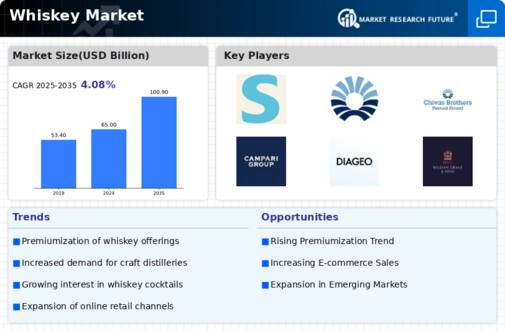The competitive landscape of the Whiskey Market is characterized by a multitude of players striving for market share in an increasingly crowded space. This industry comprises various segments, including Scotch, Irish whiskey, American whiskey, and others, each presenting unique opportunities and challenges. The growing demand for premium and artisanal products has led to heightened competition among established brands and newcomers alike. Consumer preferences are shifting towards quality and authenticity, forcing companies to innovate and enhance their offerings to meet these evolving tastes.
Moreover, the penetration of whiskey into emerging markets presents opportunities for growth, while established markets continue to solidify their positions through strategic maneuvers, branding efforts, and marketing initiatives. As the market matures, the emphasis on sustainability and responsible drinking is expected to shape competitive strategies significantly.Beam Suntory stands out in the Whiskey Market as a formidable player, leveraging its extensive portfolio of brands to secure a strong market presence. The company focuses on producing high-quality products that appeal to a variety of consumer tastes and preferences.
Beam Suntory has built a reputation for its craftsmanship, emphasizing heritage and tradition while continuing to experiment with innovative techniques. The company benefits from a well-established distribution network and strong brand recognition globally, facilitating its ability to penetrate various markets. This robust presence allows Beam Suntory to engage effectively with consumers through targeted marketing strategies, further solidifying its competitive edge in the whiskey sector.
Furthermore, the company's strategic partnerships and collaborations enhance its capabilities, allowing for more effective outreach to different demographics and market segments.Pernod Ricard holds a significant position in the Whiskey Market, showcasing a diverse array of key products that resonate with global consumers. The company’s portfolio includes several well-known whiskey brands, which are strategically positioned within various price segments to cater to a broad audience. Pernod Ricard's strengths lie in its extensive market reach, bolstered by an efficient distribution network and strong relationships with retailers and distributors worldwide.
The company invests heavily in marketing and promotional campaigns to elevate brand visibility and engagement. Pernod Ricard has been active in pursuing mergers and acquisitions to expand its footprint in the whiskey market, acquiring brands that complement its existing portfolio and offer potential for growth. This proactive approach enables Pernod Ricard to enhance its offerings and strengthen its competitive stance, positioning itself favorably to capitalize on emerging trends within the whiskey landscape on a global scale.




















